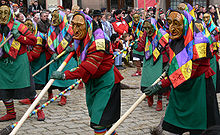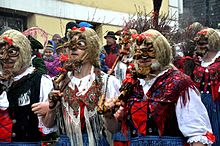Mardi Gras witch


The carnival witch is a popular fool figure, especially during the Swabian-Alemannic carnival .
history
The origin of the carnival witch has not yet been adequately clarified. Forerunners of today's witch figures have been handed down from the Middle Ages: men in women's clothes who were costumed according to the motto Upside Down World . The oldest surviving mask of a witch figure comes from Tyrol (old witch mother larva); it is dated to the 18th century . In the Tyrolean Carnival there are still figures of witches, for example at the Imster Schemenlaufen . In the 19th century, the Furtwanger witch is described as a traditional carnival figure, also in other places. These witches were mostly figures of the unorganized peasant carnival, whose craft could include not only broom movements but also rustling, as is still carried out by soot witches in Empfingen today.
Two figures from the Ortenau are considered to be the oldest carnival witches of the Swabian-Alemannic carnival with the wooden masks customary today - the Offenburg witch and the Gengenbacher witch, as well as the Löffinger witch from the Black Forest, which were introduced there in the mid-1930s.
Witch figures are, probably due to their unregulated appearing, wild behavior during fool jumps, popular with the fools and the public alike and have spread from the Ortenau to the entire area of the Swabian-Alemannic Carnival and organized in witches' guilds . They can now be found in all other regions, but less so in the particularly tradition-conscious strongholds (such as the clubs of the League of Four ).
The carnival witch figures of today's stamp probably go back to the witches known from fairy tales . The witch guilds also often refer to a local tradition of events from the early modern witch hunt. As a suggestion for the names and the design of the figures, traditional local eccentrics and originals are often used, in the Zollernalb district, however, historical witch trials. The Hexenzunft Obernheim e. V. (fool's cry: “Oho!”) Takes up an execution, the Murschel witches, however, refer to an acquittal.
Costumes
Most witches wear straw shoes, striped socks, white peasant underwear, a skirt and a jacket. The figure is also completed by a wooden mask. In individual cases, the face is also painted or covered with a wire or fabric larva (mask). The witch also carries a broom.
literature
- Jörg Kraus: The witch's way to Carnival . In: Gottfried Korff (Hrsg.): Wilde Masken. Another view of the carnival . Tübinger Vereinigung für Volkskunde, Tübingen 1989, ISBN 3-92534-058-0 , pp. 57-76
- Elisabeth Skrzypek: "The women were great ..." Women celebrate the fifth season , Reutlingen 2016, pp. 79–89
Web links
Individual evidence
- ↑ Renate Deregowski: Oberheim: witches guild celebrates its 75th anniversary. In: Schwarzwälder Bote , February 10, 2014.

